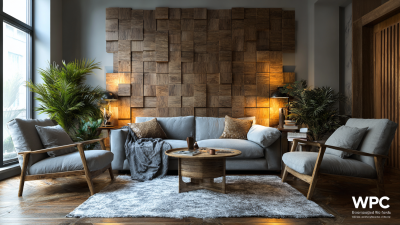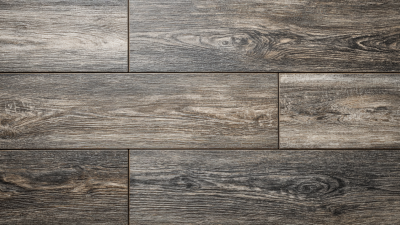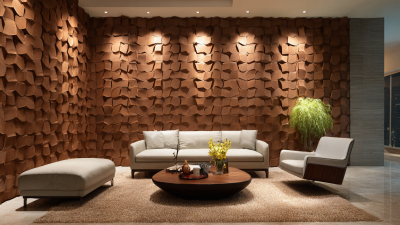Shandong Xiangying New Materials Technology Co., Ltd.
Shandong Xiangying New Materials Technology Co., Ltd.
In the realm of sustainable home improvements, Outdoor WPC Wall Panels have emerged as a revolutionary solution, merging environmental responsibility with aesthetic appeal. According to the Global WPC (Wood Plastic Composite) Market Report 2021-2026, the market is projected to grow significantly, reflecting a rising consumer demand for eco-friendly building materials. Notably, outdoor applications account for over 40% of this market, underscoring the popularity and effectiveness of WPC panels in exterior designs.

Expert in the field, Dr. Emily Tran, a leading researcher at the Sustainable Materials Institute, asserts, "The integration of Outdoor WPC Wall Panels not only enhances the visual aspects of outdoor spaces but also contributes to a substantial reduction in carbon footprint for homeowners." This seamless blend of functionality and design epitomizes the shift towards more sustainable living practices. With their durability, low maintenance needs, and resistance to environmental factors, Outdoor WPC Wall Panels are an ideal choice for those seeking to elevate their homes while supporting a sustainable future. As more homeowners become aware of these benefits, the adoption of WPC materials is set to transform the landscaping and outdoor building sectors significantly.
When considering eco-friendly home projects, WPC (Wood-Plastic Composite) wall panels offer a plethora of advantages that align perfectly with sustainable building practices. According to a report from the American Wood Council, WPC materials can be made from up to 70% recycled wood and plastic, significantly reducing the demand for virgin resources. This innovative material not only minimizes waste but also provides durability and longevity, ensuring that homeowners can enjoy the beauty of natural wood-like aesthetics without compromising on sustainability.
To maximize the benefits of WPC wall panels in your home improvement projects, consider the following tips: First, ensure that you select panels that are certified by recognized sustainability standards, such as the Forest Stewardship Council (FSC). This certification indicates that the materials used are sourced responsibly. Second, opt for composite panels with a high percentage of recycled content. According to a study by Research and Markets, such panels can reduce carbon footprints by up to 30%. Lastly, installation of WPC panels is typically straightforward, allowing for reduced labor costs and a quicker project completion time, making it an efficient choice for homeowners.
In addition to environmental benefits, WPC wall panels are highly resistant to water, insects, and decay, which enhances the lifespan of your home’s exterior. This resilience translates to lower maintenance costs and fewer repairs over time, offering both economic and environmental advantages. With these qualities, WPC wall panels stand out as a smart investment for anyone looking to improve their home sustainably.
When considering budget-friendly home improvements, WPC (Wood-Plastic Composite) wall panels emerge as an excellent choice. These panels combine the aesthetic appeal of natural wood with the resilience of high-quality plastics, making them a cost-effective alternative to traditional materials. Homeowners looking to upgrade their exterior walls can benefit from reduced maintenance costs, as WPC panels resist warping, cracking, and fading. This durability translates to fewer repairs and replacements over time, allowing homeowners to save money in the long run.
Furthermore, WPC wall panels are available in a variety of styles and finishes, making it easy to achieve a high-end look without the associated price tag. Installation costs are also lower compared to conventional materials; WPC panels are lighter and easier to handle, which can reduce labor expenses. Additionally, because these panels are designed for longevity and resistance to environmental challenges, investing in WPC wall panels can significantly enhance the overall value of a home. With such financial benefits, they are an intelligent choice for eco-conscious homeowners seeking to make sustainable improvements without straining their budgets.

When it comes to sustainable home improvements, outdoor WPC (Wood Plastic Composite) wall panels truly shine in terms of durability and low maintenance. According to a recent report by the American Society of Landscape Architects, using WPC materials can increase the lifespan of building components by up to 30 years compared to traditional wood. This extended lifespan not only means fewer replacements over time but also contributes to a reduction in waste, as fewer materials end up in landfills.
Additionally, WPC wall panels require minimal maintenance, making them an attractive option for eco-conscious homeowners. A study published in the Journal of Building Performance found that WPC materials are resistant to common issues such as rot, insect damage, and warping—problems that typically plague traditional wooden structures. With a simple cleaning routine, homeowners can extend the aesthetic appeal of their outdoor spaces without the need for costly treatments or repairs, ultimately leading to significant savings. As the housing industry increasingly shifts towards sustainable practices, opting for durable WPC solutions supports both environmental goals and economic efficiency.
| Benefit | Description | Sustainability Impact | Maintenance Level |
|---|---|---|---|
| Durability | WPC panels are resistant to rot, fading, and warping. | High impact on reducing material waste. | Low |
| Low Maintenance | Requires minimal cleaning and upkeep compared to wood. | Promotes sustainable practices by reducing chemical usage. | Very Low |
| Aesthetic Variety | Available in different colors and textures to fit any design. | Encourages use of recycled materials for diverse designs. | Low |
| Weather Resistance | Withstands harsh weather conditions without deterioration. | Reduces the need for replacement materials. | Low |
| Eco-Friendly Materials | Made from recycled wood and plastic, reducing landfill waste. | High positive impact on sustainability efforts. | Medium |
| Easy Installation | Lightweight and easy to handle for quick setup. | Saves energy and labor costs during installation. | Low |
| Non-Toxic | Free from harmful chemicals commonly found in treated wood. | Promotes a healthier living environment. | Very Low |
| Thermal Efficiency | Better insulating properties than traditional wood. | Helps in reducing energy consumption. | Low |
| Cost-Effectiveness | Long lifespan leads to savings over time. | Contributes to overall budget-friendly home improvements. | Low |
WPC (Wood Plastic Composite) wall panels are quickly becoming a favored material for enhancing outdoor spaces, providing not just functionality but also exceptional aesthetic versatility. These panels offer a wide range of colors and textures that can complement various architectural styles, making them an ideal choice for homeowners looking to upgrade the exterior design of their properties. Their ability to mimic the look of natural wood without the associated maintenance requirements means that homeowners can achieve a sophisticated appearance without compromising on durability.
Moreover, the demand for sustainable building materials is on the rise, and WPC panels fit perfectly into this trend. With a composition that often includes recycled wood and plastic, these panels contribute to eco-friendly practices in construction. By incorporating WPC wall panels into outdoor designs, homeowners are not only making a stylish statement but also promoting a healthier environment. As the market for WPC products continues to grow, it reflects a shift towards sustainable home improvements that prioritize both aesthetics and environmental responsibility.

Outdoor WPC (Wood Plastic Composite) wall panels are becoming increasingly popular among homeowners looking to make sustainable choices for their living spaces. These panels are made from recycled wood fibers and plastic, offering an eco-friendly alternative to traditional building materials. By utilizing WPC wall panels, homeowners can significantly reduce their environmental footprint while enjoying the aesthetic benefits of wood-like appearances without the associated maintenance challenges.
In addition to their sustainable composition, WPC wall panels provide excellent durability and weather resistance, making them suitable for outdoor applications. They do not warp, crack, or splinter like conventional wood, ensuring longer-lasting beauty and functionality. This durability translates into fewer replacements over time, further minimizing resource use and waste. By investing in outdoor WPC wall panels, homeowners are not only enhancing their properties but also contributing to a more sustainable future, showcasing their commitment to environmentally responsible living.






